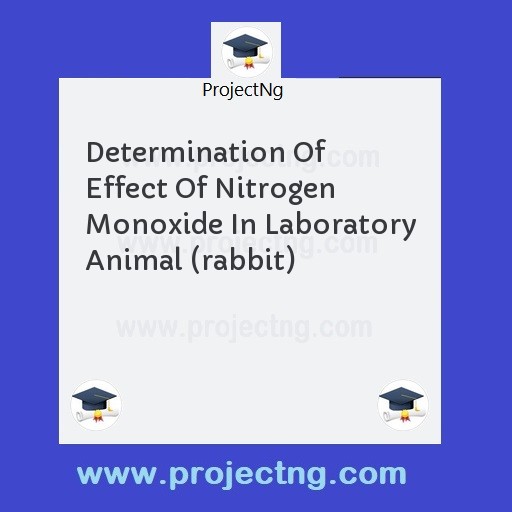Determination Of Effect Of Nitrogen Monoxide In Laboratory Animal (rabbit)
Science Lab Technology Project Topics
Get the Complete Project Materials Now! »
DETERMINATION OF EFFECT OF NITROGEN MONOXIDE IN LABORATORY ANIMAL (RABBIT)
ABSTRACT
The project effects of No2 oxide on laboratory animals was carried out by injecting the experimental animals with NO2 of different doses 25.00, 30.00, 35.00, 40.00, 45.00 and 50.00. the animals were injected according to their body Weight. The least weight was injected with the lowest does and the highest animals with highest does. This is to avoid abnormal reaction of the doses. After two days the animal begins to develop early symptoms of different breathing, body swollen, dizzy and death. The death of the animal brings the observation to an end. This shows that environmental condition (pollution) can lead to death as a result of long term exposure. The method used for the injection were injection, (through the skin).
CHAPTER ONE
1.0 INTRODUCTION
1.1BACKGROUND OF THE STUDY
Air pollution is the introduction of chemical particulates, biological materials, or other harmful materials into the earth’s atmosphere, possibly causing disease, death to humans, damage to animals and other living organisms such as food crops or the natural or built environment (Dainel, 2010), the atmosphere is a complex natural gaseous system that is essential to support life on planet earth. Stratospheric ozone depletion due to air pollution has long been recognized as a threat to human as will as to the Earth’s ecosystems. In door air pollution and urban are quality are hosted as too the worlds worst toxic pollution problem in the 2008 black smooth institute worlds worst pollute places reported. Air pollution is a substance in the air that can have adverse effects on humans and the ecosystem. The substance can be solid particles, required droplets, or gases. A pollutant can be of natural origin or man-made (Adernson, 2011). Pollutants are classified as primary or secondary. Primary or secondary. Primary pollutants are usually produce from a process such as from volcanic eruption Other examples include carbon monoxide gas from motor vehicle exhaust, or the sulfur dioxide released from factories (Brook, 2010 secondary pollutants are not emitted directly, rather, they form in the air when primary pollutants react or interact (Sahagun, 2008) ground level ozone is a prominent example of a secondary pollutant. Some pollutants may be both primary and secondary they are both emitted directly and formed other primary pollutants (Barath, 2008).
Major primary pollutants produced by human activity includes;
Sulfur oxides (S02) - particularly sulfur dioxide a chemical compound with the formular so2 is produced by volcanoes and the various industrial processes (Goldsteen, 2009). Loan and petrotknm often contain sulfur compounds and their combustion generates sulfur dioxide. Furthermore oxidation of so2, usually in the presence of a catalytic such as No2 form H2so4, and thus acid rain (Marteen, 2011) this is one of the causes for concern over the environmental impact of the use of these fuels as power sources (Marteen, 2011).
Nitrogen oxide (Nox)- Nitrogen oxides particularly nitrogen dioxide, are expelled from high temperature combustion and are also produced during thunderstorm by electric discharge. They can be seen as brown haze dome above or plume down wind of cities. Nitrogen dioxide is a chemical compound with the formular No2. it is one of the several nitrogen oxides. One of the most prominent air pollutants, this reddish-brown toxic gas has a characteristic sharp, biting odor (Tankersley, 2010).
Carbon monoxide (CO) –is – colouless, odourless, toxic yet non irritating gas. It is product by incomplete combustion of filed such as natural gas, coal or wood. Vehicular exhaust is a major source of carbon monoxide (Grossni, 2008). Volatile organic compounds-VOCS are a well known outdoor air pollutant. They are categorized as either methane (CH4) or no-methane. Methane is an extremely efficient green house gas which contributes to enhanced global worming. Other hydrocarbon (VOCS) are also significant green-house gases because of their role in creating ozone and prolonging this life of methane in the atmosphere this effect varies depending on local air quality (Kanfmen, 2007)
Ammonia (NH3)-Compound of nitrogen emitted from agricultural processes. Ammonia is compound with the formular NH3. It is normally encountered as a gas with a characteristic pungent odor. Ammonia contributes significantly to the nutritional needs of terrestrial organisms by serving as a precursor of food stuffs and fertilizers. Ammonia directly for indirectly, it is all building block for the synthesis in many pharmaceuticals. Although in wide use ammonia is both caustic and hazardous (Michael, 2008).
1.2 OBJECTIVE OF THE STUDY
The objective of this is to verity the effect nitrogen dioxide in laboratory animals. For the fact that in some pharmacentic industries, after production of drugs laboratory animals are used to rest the effect of or toxicity of drugs, because the drugs effect on that animals will also be the effect on human. For the aim of this study to know the effect of (NO2) when impact into laboratory animals, for effect on animal will also be the same effect on human.
1.3 STATEMENT OF THE PROBLEM
Nitrogen monoxide as an air pollutant has been complaining by people as an agent of lung cancer, this lead to the study for fund out the exact effect on human through laboratory animals. Though in different concentration.
1.4 SIGNIFICANCE OF THE STUDY
This will help the populace to know the actual effect of (No2) on animal. And this will help for the final conclusion of its almost the same body system with human.
1.5 LIMITATION BODY SYSTEM WITH HUMAN
This study limits on the effect of air pollution (No) on laboratory animals. Other factor that may come in are time and financial constraints.
Be the First to Share On Social

Enjoying our content?
Don't miss out on new videos! Subscribe to our YouTube channel for more awesome content.
Subscribe Now!













